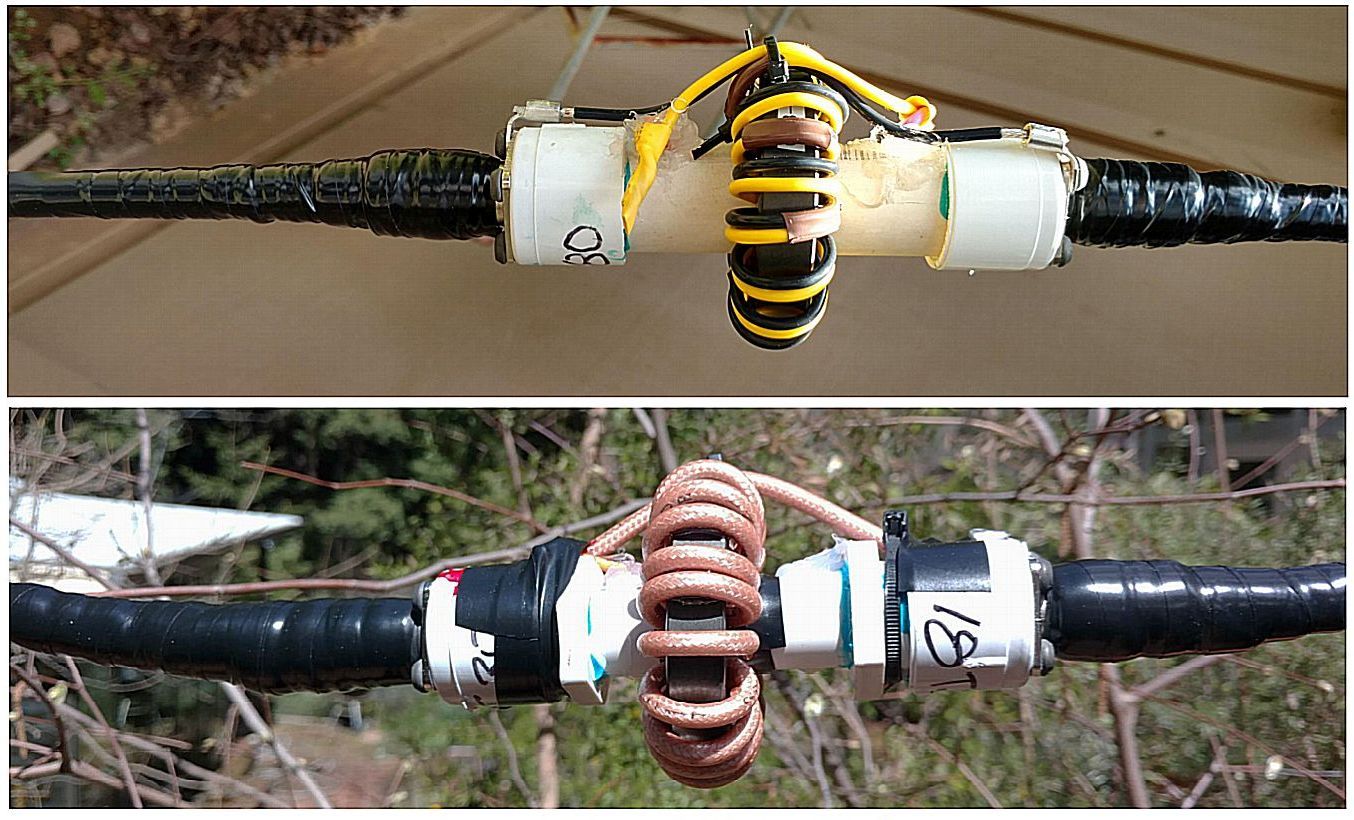
| << |
Curing feeder common mode problems. |
Induced RF.
Every feeder can receive noises
from the
surroundings.
Every feeder can receive RF radiated from the connected antenna.
These in the feeder induced noises and RF cause common mode currents on
the outside surface of a feeder coax screening (the common mode circuit).
And then
will travel to the antenna and the the transceiver.
These noises will be heard in
the receiver.
These RF currents will cause problems.
We can block them.
Common mode resonance.
At feeder lengths of 1/2 lambda, or a multiple of
1/2 lambda (of the frequency
where the transceiver is tuned to),
a feeder will show common mode resonance.
Feeder 1/2 lambda resonance can (will) cause trouble :
- Hinder due to received amplified noises,
received by
the feeder from surroundings.
- TVI, BCI, RF in audio- and telephone equipment in your house.
- And in the house of neighbors.
- Strong RF in the radio room.
- When transmitting, painful RF voltages on the transceiver cabinet and
microphone.
- When transmitting, RF voltages on the microphone, causing "Feed back" (heavy
speech modulation distortion).
You should insert good common mode chokes into the feeder at :
1. First : at the antenna connector of
the transmitter, or at the antenna connector of an external antenna tuner.
2. Starting from the tuner every 1/4 lambda for the highest
frequency band to be used.
Every max. 5m distances if the 20m
band is the highest band to be used.
Every max. 7.5m distances if the 30m band is the
highest band to be used.
Every max. 10m distances if the 40m band is the
highest band to be used.
Every max. 20m distances if the 80m band is the
highest band to be used.
Every max. 40m distances if the 160m band is the
highest band to be used.

Construction.
The choke construction
shown here has the following advantages :
- You do not have to wind 100m coax
through one or more ferrite cores.
- You can, during bad weather, construct all common mode chokes, and all coax cable pieces, at
forehand inside the house.
- You quickly can install it all later on, during good weather.
- Experiments with exchanging different chokes are easy.
- A choke can be omitted by removing it and connecting the coax cable parts with a female
- female connector.
- Exchanging for repair is easy.
- But it costs money for connectors and busses.
These common mode chokes are shifted onto
a piece of PPC tube, which is closed by caps with N-type female
busses mounted into them.
They are wound the same way like the antenna
choke
Wind 17 turns for the feeder CMCs.. The bi-filar version is likely the most easy to make.
For coax common mode chokes you could use :
- 5mm RG300 PTFE silver plated, double screening and small bending
radius,
- 5mm RG223/U silver plated, double screening and small bending
radius,
- 5mm Belden H155 double screening and small bending radius, moist
resist foam dielectric
Moist coaxes become useless.
Their VSWR become very bad.
AND they can
act as a rain pipe, causing water dripping into your room or equipment.
Internal wet coax must be renewed. REM : be careful not to damage the
outer insulation.
Care must therefore be taken for water proofing CMC coax, the N-busses and the plugs, to prevent that ANY moist can intrude into the coaxes.
Use petroleum gel (Vaseline) for
threads and all connector places where water can seep in. A little on contact
surfaces does not harm.
Remove excess and seal the connectors with vulcanizing butyl tape. Do not insulate the choke, it should be cooled by air.
Buying materials.
Make an order of more than 50 Euro at an industrial supplier like Mouser.com ,
Arrow.com
etc.
You will get rabat (depending on the number of pieces ordered), FREE packaging
and postage, price including customs costs.
No extra costs afterwards. Fast delivery.
Then one 61mm #31 core will cost less than 5 Euro/piece.
Search Aliexpress for RG300 coax, and PTFE silver plated colored supple wire.